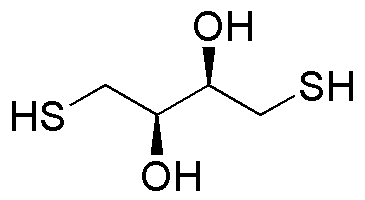L-Dithiothreitol is widely utilized in research focused on:
- Protein Stabilization: It is commonly used to maintain the reduced state of proteins during purification processes, preventing oxidation and preserving their functional integrity.
- Cell Culture: In cell biology, it helps to reduce disulfide bonds in proteins, promoting cell viability and enhancing the growth of sensitive cell lines.
- Biochemical Assays: Researchers use it in various assays to ensure accurate measurements of enzyme activity by keeping proteins in their active forms.
- Antioxidant Applications: Its reducing properties make it effective in protecting cells from oxidative stress, which is crucial in studies related to aging and disease.
- Drug Formulation: In pharmaceutical development, it serves as a stabilizing agent for certain drugs, improving their shelf life and efficacy.
General Information
Properties
Safety and Regulations
Applications
L-Dithiothreitol is widely utilized in research focused on:
- Protein Stabilization: It is commonly used to maintain the reduced state of proteins during purification processes, preventing oxidation and preserving their functional integrity.
- Cell Culture: In cell biology, it helps to reduce disulfide bonds in proteins, promoting cell viability and enhancing the growth of sensitive cell lines.
- Biochemical Assays: Researchers use it in various assays to ensure accurate measurements of enzyme activity by keeping proteins in their active forms.
- Antioxidant Applications: Its reducing properties make it effective in protecting cells from oxidative stress, which is crucial in studies related to aging and disease.
- Drug Formulation: In pharmaceutical development, it serves as a stabilizing agent for certain drugs, improving their shelf life and efficacy.
Documents
Safety Data Sheets (SDS)
The SDS provides comprehensive safety information on handling, storage, and disposal of the product.
Product Specification (PS)
The PS provides a comprehensive breakdown of the product’s properties, including chemical composition, physical state, purity, and storage requirements. It also details acceptable quality ranges and the product's intended applications.
Certificates of Analysis (COA)
Search for Certificates of Analysis (COA) by entering the products Lot Number. Lot and Batch Numbers can be found on a product’s label following the words ‘Lot’ or ‘Batch’.
*Catalog Number
*Lot Number
Certificates Of Origin (COO)
This COO confirms the country where the product was manufactured, and also details the materials and components used in it and whether it is derived from natural, synthetic, or other specific sources. This certificate may be required for customs, trade, and regulatory compliance.
*Catalog Number
*Lot Number
Safety Data Sheets (SDS)
The SDS provides comprehensive safety information on handling, storage, and disposal of the product.
DownloadProduct Specification (PS)
The PS provides a comprehensive breakdown of the product’s properties, including chemical composition, physical state, purity, and storage requirements. It also details acceptable quality ranges and the product's intended applications.
DownloadCertificates of Analysis (COA)
Search for Certificates of Analysis (COA) by entering the products Lot Number. Lot and Batch Numbers can be found on a product’s label following the words ‘Lot’ or ‘Batch’.
*Catalog Number
*Lot Number
Certificates Of Origin (COO)
This COO confirms the country where the product was manufactured, and also details the materials and components used in it and whether it is derived from natural, synthetic, or other specific sources. This certificate may be required for customs, trade, and regulatory compliance.


